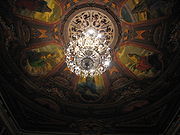
Architecture of Colombia
Encyclopedia
Despite Colombia
's multiple cultural heritage (European, Indian and African), its architecture is mostly the result of adapting European models to local conditions. The country's colonial buildings reflect their Spanish (and particularly Andalusian) origin, as seen in the traditional single-story houses laid around a central patio, to be found both in colonial towns such as Santafé (Bogotá
), Tunja or Cartagena, or in rural haciendas throughout the country. After gaining its independence, Colombia severed its links with Spain and looked elsewhere for new models, first England, then France, marking the beginning of what became known as Republican Architecture (Arquitectura republicana), an era that lasted well into the twentieth century, when the changes in architectural thinking in Europe brought Modern Architecture to the country during the last years before World War II.
architecture reflects seventeenth century Spanish colonial origins. Regional differences derive from those found in Spain. Thus, hints of Moorish and Castilian architecture are evident in many cities. Many areas have had difficulty maintaining older structures, and the climate has destroyed many Baroque
buildings. The many churches that dot the landscape are among the country's architectural gems, whose interiors reflect the influence of Medieval and Renaissance churches in Spain. Newer buildings in larger cities utilize modern styles with adaptations of the Baroque style supplemented with wood and wrought-iron elements.

government tore down many older buildings to reject the conservative past. In their place, it constructed modern buildings with an international flavor.
, or the Torres del Parque by the famed architect Rogelio Salmona
.
Colombia
Colombia, officially the Republic of Colombia , is a unitary constitutional republic comprising thirty-two departments. The country is located in northwestern South America, bordered to the east by Venezuela and Brazil; to the south by Ecuador and Peru; to the north by the Caribbean Sea; to the...
's multiple cultural heritage (European, Indian and African), its architecture is mostly the result of adapting European models to local conditions. The country's colonial buildings reflect their Spanish (and particularly Andalusian) origin, as seen in the traditional single-story houses laid around a central patio, to be found both in colonial towns such as Santafé (Bogotá
Bogotá
Bogotá, Distrito Capital , from 1991 to 2000 called Santa Fé de Bogotá, is the capital, and largest city, of Colombia. It is also designated by the national constitution as the capital of the department of Cundinamarca, even though the city of Bogotá now comprises an independent Capital district...
), Tunja or Cartagena, or in rural haciendas throughout the country. After gaining its independence, Colombia severed its links with Spain and looked elsewhere for new models, first England, then France, marking the beginning of what became known as Republican Architecture (Arquitectura republicana), an era that lasted well into the twentieth century, when the changes in architectural thinking in Europe brought Modern Architecture to the country during the last years before World War II.
Colonial period
ColombianColombian people
Colombian people are from a multiethnic Spanish speaking nation in South America called Colombia. Colombians are predominantly Roman Catholic and are a mixture of Europeans, Africans, and Amerindians.-Demography:...
architecture reflects seventeenth century Spanish colonial origins. Regional differences derive from those found in Spain. Thus, hints of Moorish and Castilian architecture are evident in many cities. Many areas have had difficulty maintaining older structures, and the climate has destroyed many Baroque
Baroque
The Baroque is a period and the style that used exaggerated motion and clear, easily interpreted detail to produce drama, tension, exuberance, and grandeur in sculpture, painting, literature, dance, and music...
buildings. The many churches that dot the landscape are among the country's architectural gems, whose interiors reflect the influence of Medieval and Renaissance churches in Spain. Newer buildings in larger cities utilize modern styles with adaptations of the Baroque style supplemented with wood and wrought-iron elements.
Republican (Republicano) Period

Modern architecture in Colombia
In the 1930s, Colombia began to embrace modern architecture. The new Liberal PartyColombian Liberal Party
The Colombian Liberal Party is a center-left party in Colombia that adheres to social democracy and social liberalism.The Party was founded in 1848 and, together with the Colombian Conservative Party, subsequently became one of the two main political forces in the country for over a century.After...
government tore down many older buildings to reject the conservative past. In their place, it constructed modern buildings with an international flavor.
Housing developments
Until the mid-1940s, most Colombians lived in single-family dwellings built of cinder blocks and covered with an adobe made of clay, cow manure, and hay. Uncontrolled urban growth due to massive migration from rural areas resulted in hughe informal settlements which make up the bulk of Colombia's housing problem up to the present time. Nonetheless, there have been a few notable examples of high-density housing projects (aimed, however, at the rising middle-classes) such as the Centro Antonio Nariño, which followed the principles of Le CorbusierLe Corbusier
Charles-Édouard Jeanneret, better known as Le Corbusier , was a Swiss-born French architect, designer, urbanist, writer and painter, famous for being one of the pioneers of what now is called modern architecture. He was born in Switzerland and became a French citizen in 1930...
, or the Torres del Parque by the famed architect Rogelio Salmona
Rogelio Salmona
Rogelio Salmona was a Colombian architect of Sephardic and Occitan descent. He was noted for his extensive use of red brick in his buildings and for using natural shapes like spirals, radial geometry and curves in his designs...
.

